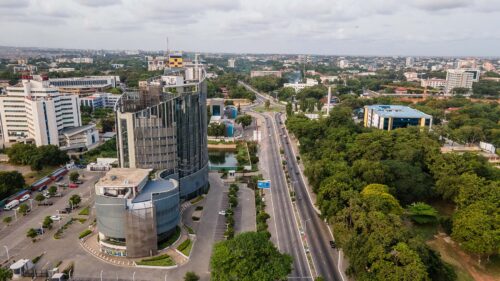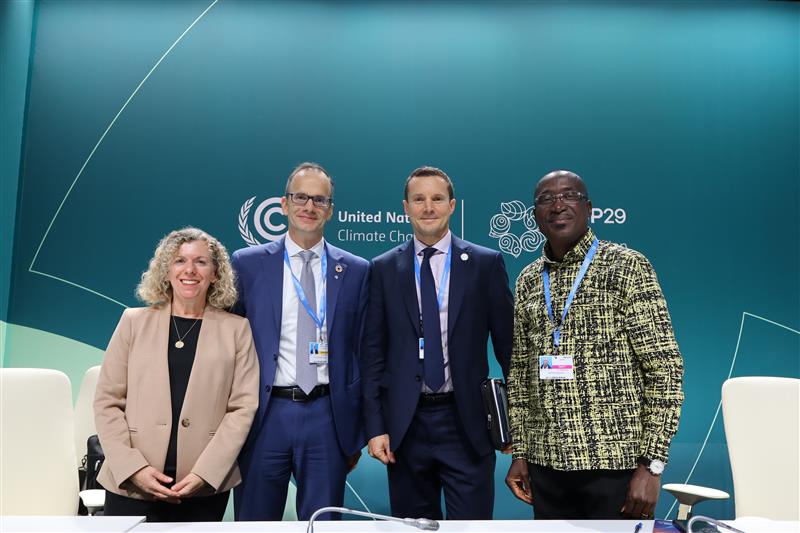
The Energy Efficiency Journey in Ghana
An interview with Mr. Kofi A. Agyarko, director of renewable energy, energy efficiency and climate change at the Energy Commission.
Ghana, home to 35 million people and diverse ecosystems ranging from rainforests to coastal wetlands, stands out for its strong commitment to energy efficiency. Ghana has supported the Mission Efficiency Call to Action, the Global Renewable Energy and Energy Efficiency Pledge, and the Cooling Pledge. The West African country also recently participated in Mission Efficiency’s COP 29 press conference stressing the urgency and opportunity for countries to embrace energy efficiency. Mission Efficiency interviewed Mr. Kofi A. Agyarko, director of renewable energy, energy efficiency and climate change at the Energy Commission to learn more about how Ghana is harnessing the power of energy efficiency.

Lisa Jacobson, President of BCSE; Jon Creyts, CEO RMI; Bruce Douglas, CEO Global Renewables Alliance; Kofi Agyarko, Director, Renewable Energy and Energy Efficiency, Energy Commission of Ghana
What inspired you to focus on energy efficiency in Ghana?
The inspiration to focus on energy efficiency in Ghana hinges on several factors but the most important ones are as follows:
Resource constraints. It became abundantly clear in the 1990s that the Akosombo and the Kpong dams, which provided cheap hydroelectric power, were inadequate to meet the growing energy demand arising from population and economic growth.
Dumping of inefficient appliances: The middle-income bracket began to expand, and disposable incomes also increased, affecting appliance consumption. Unfortunately, the availability and affordability of new and efficient appliances were challenging, so people resorted to used or second-hand appliances imported from Europe and elsewhere, which have outlived the technical lifespan and for that matter, consumed high energy. This situation resulted in high penetration of used and inefficient appliances in the country leading to a loss of 30 percent of annual electricity generation.
International commitments. Ghana had become a signatory of all the international protocols seeking to protect the environment. The most plausible thing to do was to embark on an energy efficiency journey to:
-
- forestall further aggravating the situation,
- ensure that energy consumption grew at a reducing rate, and
- meet global emission commitments.
Which measures proved to be the most impactful in driving market transformation?
A combination of policy, information and incentives. We increased the tally of MEPS [Minimum Energy Performance Standards]-covered appliances from 3 to 19 with the existing 3 reviewed and improved as of November 2022 through the Millennium Development Corporation’s Compact II funding. We introduced market intervention policies and financing mechanisms to facilitate the market penetration of energy-efficient appliances. In 2007, 6 million compact fluorescent lights were distributed to consumers free of charge to replace incandescent bulbs. A rebate scheme was also introduced in 2012 to assist consumers in buying new and energy-efficient refrigerators. These market and financing mechanisms were deliberately introduced to whet consumers’ appetite for energy-efficient appliances, accelerate their market uptake, and transform the market.
What benefits have these policies delivered, both in terms of energy savings and broader non-energy impacts?
There were significant savings in terms of energy emissions and costs. The lighting retrofit saved Ghana 124 megawatts of peak load and produced carbon dioxide savings of 112,340 kgs. On average, households saved US$31 on their bills annually and US$105 million of investment in generation capacity expansion was deferred to 2011 from 2008.
On average, households saved US$31 on their bills annually and US$105 million of investment in generation capacity expansion was deferred to 2011 from 2008.
The savings enabled additional benefits in terms of energy access, which grew by 7.6 percent in 2014, largely attributed to the refrigerator market transformation project. This was funded by the Global Environment Facility (GEF) under the auspices of the UNDP and saw the introduction of over 9,000 new and efficient refrigerators into homes in exchange for old and inefficient ones which drove down consumption of the average refrigerator from 1,200 kWh/y to 380 kWh/y resulting in an average savings of $80 a year to the consumer. This made it possible for consumers to change their fridges every five years from the savings. The refrigerator project saved 400 GWh — equivalent to more than 40 percent of Bui Hydro Dam’s annual output of 900 GWh. Carbon dioxide savings was 1.1 million tons, while CFC [chlorofluorocarbons] recovered was 1,500 kgs.
The refrigerator project saved 400 GWh — equivalent to more than 40 percent of Bui Hydro Dam’s annual output of 900 GWh.
Yellow labels were introduced to educate consumers on energy efficiency levels and have become common symbols of efficiency in households. Unlabeled and one-star rated appliances have become difficult to sell as attested by the retailers.
What are the next steps for Ghana as it continues its energy efficiency journey?
We plan to tackle energy efficiency in buildings in earnest. It has been observed that buildings consume more energy depending on the design. For instance, glass-encased buildings are gaining traction in Ghana because they look attractive but require a lot of cooling for comfort. We have started to assess and deploy solutions for public buildings, such as hotels, shopping malls, and other places of public patronage and with time, we hope to extend it to private dwellings.
Ghana has incorporated energy efficiency in cooling solutions and is looking forward to leapfrogging to newer energy-efficient technologies with low global warming potential refrigerants to meet its international obligations to the Kigali amendment under the Montreal Protocol. Countries need to consider passive cooling as well as energy efficiency in buildings in their NDCs [nationally determined contributions]. Cooling is no longer a luxury but rather a necessity. Therefore, it is best to take advantage by showing commitment and securing funding to implement the necessary energy efficiency measures.
Cooling is no longer a luxury but rather a necessity.
We have been inspired to accelerate the energy efficiency agenda by joining the Cooling Pledge, Mission Efficiency Call to Action, the Super-Efficient Equipment Appliance Deployment (SEAD), and many more.
We are also seeking funding to support incentive programmes for the uptake of appliances under the new energy efficiency regulations. Every appliance, from the kitchen to the factory, has come under the appliance standards and labeling regime.
What advice or lessons would you share with other countries looking to implement similar energy efficiency measures and policies?
Many countries are not showing commitment to energy efficiency because they are waiting for the right time, which will never come. Do not always rely on foreign assistance because utilization of local resources makes you take ownership of the energy efficiency drive. Many low-hanging fruits exist which do not need much expertise and a huge financial layout. You can always start and strengthen! Many toolkits abound that do not require re-inventing the wheel. You do not need to be an energy efficiency expert before you begin to act. Many countries are not acting because they are waiting to raise experts first and acquire all the necessary tools. Champions with a passion for success to drive the process are all you need to start with. Opportunities now abound for international collaboration that must be harnessed and utilized. It is instructive to note that the ability to enforce the regulations is critical in developing countries. But if the willingness is there, you better start it!
Champions with a passion for success to drive the process are all you need to start with.
About Mission Efficiency
Mission Efficiency is a global collective of actions, commitments and goals on energy efficiency by a coalition of governments, organizations and initiatives. Mission Efficiency unites partners to accelerate the transition towards energy efficient economies worldwide. https://missionefficiency.org/
